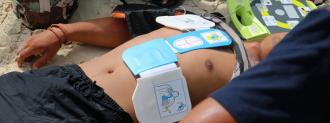The Washington Post asks a question: should the U.S. try to more broadly adopt the use of apps that help volunteers reach people suffering from cardiac arrest — volunteers who can arrive faster than an ambulance and EMS personnel?
Data out of Denmark makes a strong case for yes. The whole country is covered by an app called Heartrunner — or, in Danish, TrygFonden Hjerteløber — that calls in volunteers to cardiac arrest victims. And the country has seen out-of-hospital cardiac arrest survival rates climb dramatically, the Post reports.
Cardiac arrest vs. heart attack: As the Post and other outlets got wrong a few times, Heartrunner is designed to help cardiac arrest victims, not those suffering heart attacks; the two conditions, while interrelated, are not the same.
Think of it like this: a heart attack is a plumbing problem, while a cardiac arrest is an electrical problem. In a heart attack, an obstruction prevents blood (carrying sweet, delicious oxygen) from reaching parts of the heart. Eventually, the starved smooth muscle tissue is damaged and dies.
Sudden cardiac arrest occurs when an electrical malfunction in the heart throws the heart off beat. Its pumping now disrupted, the heart becomes incapable of getting blood to where it needs to be — including the brain and lungs.
Loss of consciousness and pulse can happen within seconds; death within minutes.
As you can guess, time is of the absolute essence in these cases; treatment delayed by even minutes can mean death.
According to the American Heart Association, cardiac arrest is reversible, but only if you work fast. The AHA says to call 911 first, then find an AED if you can.
AED stands for automated external defibrillator, and it’s essentially a smaller, safer, and easier-to-use version of those “clear!” drama-piquing paddles all TV hospitals rely on.
The AED’s job is to shock the heart back into rhythm, and the AHA says to use it as soon as it arrives. They also recommend performing CPR — chest compressions to, of course, “Stayin’ Alive” — and continuing to do so until EMS arrives. Taking these steps can double or triple someone’s chances of survival.
Heartrunner’s goal is to get volunteers, who they call citizen responders, and AEDs to cardiac arrest victims, STAT.
Run for their life: Denmark became the first country in Europe completely covered by Heartrunner in 2020, where it reaches over 111,000 citizen responders — 75% with no professional training, the Post reports. However, a study in the Journal of the American College of Cardiology of citizen responders in Copenhagen did find that 99% of the volunteers had CPR training.
The Post breaks down how it works for the Danes: The country’s emergency services number, 112, can contact up to 20 volunteers within 1.1 miles (I mean, 1.77 km) of a cardiac arrest scene.
The app asks volunteers “can you run?” (presumably in Danish) and directs them either to the address of the victim or the nearest AED, which should be grabbed en route. Once they arrive, citizen responders administer CPR and use the AED, helping to keep the patient alive until EMS arrives.
Cardiac arrest victims were three times more likely to have been defibrillated before the ambulance arrived when citizen responders were alerted.
Less clear thus far is the direct impact on survival rates, although study lead author Linn Andelius believes that it potentially can save lives. Still, “it is very important to evaluate this in a correct way,” Andelius told TCTMD.
“Otherwise we cannot ask citizen responders to devote their time and expose them to the potential risk of physical or psychological injury.”
A U.S. Jumpstart? University of Washington professor of medicine Thomas Rea told WaPo that there is “no reason why we should not pursue this.” When one considers that the U.S. out-of-hospital cardiac arrest survival rate is a shade under 10% — and lower now, thanks to the pandemic — he may have a point.
According to the Post, 70% of out-of-hospital cardiac arrest cases occur in private residences, leading experts to believe that getting emergency help to the home could be key in increasing survival rates.
There is a North American responder app already, PulsePoint, but concerns about safety and people’s receptiveness to strangers coming into their homes has kept it from widespread use, the Post says. PulsePoint alerts CPR-trained volunteers or off-duty first responders to cardiac arrest incidents around them, generally in public places.
Some pilot communities have been using PulsePoint to send responders to residences, but thus far only professionals; there are safety concerns with sending volunteers into a stranger’s house. According to Rea, who’s studied the pilots, the responders have been well received thus far, however.
“Maybe we’re not thinking forward quite as fast as we could,” he said.
Copenhagen Emergency Medical Services director Freddy Lippert told the Post that he had no concerns about Heartrunner sending volunteers.
“The patient is dead, and if you don’t do anything, 9 out of 10 will be dead forever.”
We’d love to hear from you! If you have a comment about this article or if you have a tip for a future Freethink story, please email us at [email protected].






